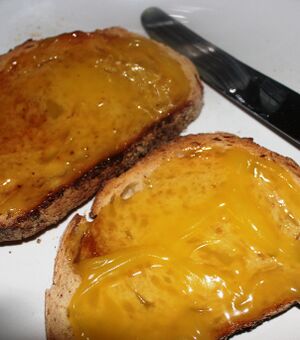Category: Emulsification: Difference between revisions
No edit summary |
No edit summary |
||
| Line 1: | Line 1: | ||
<!-- seo --> | |||
{{#seo: | |||
|title=Emulsification, a Molecular gastronomy cooking method | |||
|titlemode=replace | |||
|keywords=Emulsification,Modernist Cuisine, molecular gastronomy | |||
|description=Emulsification is the binding together of two normally incompatible liquids such as oil and water by means of an emulsifying agent | |||
|og:image=https://www.cookipedia.co.uk/wiki/images/3/38/Olive_oil_%27butter%27_recipe.jpg | |||
|og:type=article | |||
}} | |||
<!-- /seo --> | |||
[[Image:Olive oil 'butter' recipe.jpg|thumb|300px|right|[[Olive oil spread|Olive oil 'butter']]]] | |||
Emulsification is the binding together of two normally incompatible liquids such as [[oil]] and water by means of an emulsifying agent (or emulsifier) and these bound liquids are known as emulsions. Some emulsions, such as [[egg yolks]] are naturally emulsified due to the presence of an emulsifier, in this case [[Soy lecithin|lecithin]]. Many however, including [[margarine]], [[ice cream]], [[mayonnaise]], and [[salad dressings]] require an emulsifying agent to be added for example, [[soy lecithin]], [[egg yolks]], gums, proteins and fatty acids such as [[Mono and Diglyceride (Glice)|mono- and diglycerides]] | Emulsification is the binding together of two normally incompatible liquids such as [[oil]] and water by means of an emulsifying agent (or emulsifier) and these bound liquids are known as emulsions. Some emulsions, such as [[egg yolks]] are naturally emulsified due to the presence of an emulsifier, in this case [[Soy lecithin|lecithin]]. Many however, including [[margarine]], [[ice cream]], [[mayonnaise]], and [[salad dressings]] require an emulsifying agent to be added for example, [[soy lecithin]], [[egg yolks]], gums, proteins and fatty acids such as [[Mono and Diglyceride (Glice)|mono- and diglycerides]] | ||
Latest revision as of 11:48, 2 March 2016

Emulsification is the binding together of two normally incompatible liquids such as oil and water by means of an emulsifying agent (or emulsifier) and these bound liquids are known as emulsions. Some emulsions, such as egg yolks are naturally emulsified due to the presence of an emulsifier, in this case lecithin. Many however, including margarine, ice cream, mayonnaise, and salad dressings require an emulsifying agent to be added for example, soy lecithin, egg yolks, gums, proteins and fatty acids such as mono- and diglycerides
Emulsifiers work by coating the liquid’s molecules which causes them to mix better with other ingredients and this normally done by beating, whisking or whipping with the aid of a gadget of some description. When following a recipe, it may be important to mix ingredients in the order given for any emulsification to work. Also ingredient temperature may also dictate the success or failure of an emulsion eg mayonnaise ingredients should be at room temperature to help prevent curdling. In modernist cuisine popular emulsions are Airs (soy lecithin) and Foams (soy lecithin or mono- and diglycerides).
Pages in category ‘Emulsification’
The following 2 pages are in this category, out of 2 total.